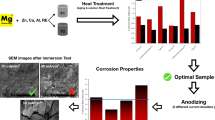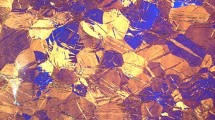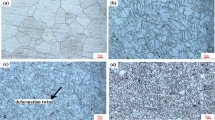Abstract
The magnesium alloys are promising candidates for biodegradable medical implants which reduce the necessity of second surgery to remove the implants. Yttrium in solid solution is an attractive alloying element because it improves mechanical properties and exhibits suitable corrosion properties. Silver was shown to have an antibacterial effect. The effect of Y and Nd solutes on the corrosion, mechanical and thermal properties of Mg–4Y–2Nd–1Ag (in mass%) and Mg–2Y–1Nd–1Ag (in mass%) alloys prepared by gravity casting has been investigated. The alloys were isothermally annealed at two temperatures: 500 °C/24 h and 525 °C/24 h. Microhardness (HV 0.1) together with differential scanning calorimetry measurements were compared to microstructure development that was observed by transmission and scanning electron microscopy. Corrosion behaviour was studied by using electrochemical measurements and hydrogen evolution test. In the Mg–4Y–2Nd–1Ag alloy annealed at 500 °C/24 h, one exothermic process was observed; in the Mg–4Y–2Nd–1Ag alloy annealed at 525 °C/24 h, two exothermic processes were observed. The activation energies of these processes were calculated by Kissinger method as ~ 140 kJ mol−1 for the alloy annealed at 500 °C/24 h and ~ 115 kJ mol−1 and ~ 120 kJ mol−1 for the alloy annealed at 525 °C/24 h. No thermal processes were observed in the Mg–2Y–1Nd–1Ag alloys. The results showed that the alloys with the lower amount of Y and Nd solutes exhibit considerably higher corrosion resistance. Unlike in the Mg–2Y–1Nd–1Ag alloy, the corrosion rate of the Mg–4Y–2Nd–1Ag in physiological environment increases with the time of immersion. It was found that isothermal heat treatments lead to an improvement of corrosion properties in both studied alloys but affect microhardness only moderately.









Similar content being viewed by others
References
Tie D, Feyerabend F, Müller WD, Schade R, Liefeith K, Kainer KU, Willumeit R. Antibacterial biodegradable Mg–Ag alloys. Eur Cell Mater. 2012. https://doi.org/10.22203/eCM.v025a20.
Myrissa A, Agha NA, Lu Y, Martinelli E, Eichler J, Szakács G, Kleinhans C, Willumeit-Römer R, Schäfer U, Weinberg AM. In vitro and in vivo comparison of binary Mg alloys and pure Mg. Mater Sci Eng C. 2016. https://doi.org/10.1016/j.msec.2015.12.064.
Jafari H, Khalilnezhad M, Farahany S. Computer-aided cooling curve thermal analysis and microstructural evolution of Mg–5Zn–xY cast alloys. J Therm Anal Calorim. 2017. https://doi.org/10.1007/s10973-017-6144-4.
Liu M, Schmutz P, Uggowitzer PJ, Song G, Atrens A. The influence of yttrium (Y) on the corrosion of Mg–Y binary alloys. Corros Sci. 2010. https://doi.org/10.1016/j.corsci.2010.07.019.
Guo E, Wang L, Feng Y, Wang L, Chen Y. Effect of cooling rate on the microstructure and solidification parameters of Mg–3Al–3Nd alloy. J Therm Anal Calorim. 2019. https://doi.org/10.1007/s10973-018-7446-x.
Król M, Staszuk M, Mikuszewski T, Kuc D. Refinement effect of RE in light weight Mg–Li–Al alloys. J Therm Anal Calorim. 2018. https://doi.org/10.1007/s10973-018-7290-z.
Reardon KA, Mc Intosh AF, Shilling AT, Hagspiel KD, Al-Osaimi A, Berg C, Caldwell SH, Northup PG, Angle F, Mulder R, et al. Treatment of primary liver tumors with Yttrium-90 microspheres (TheraSphere) in high risk patients: analysis of survival and toxicities. Technol Cancer Res Treat. 2009. https://doi.org/10.1177/153303460900800109.
Kyker GC, Anderson EB. Chemical toxicity of salts of lanthanum, yttrium and some other rare metals to animals. In: Rare earths in biochemical and medical research. Ann Arbor: University of Michigan Library; 1955. pp. 91–101.
Vlček M, Lukáč F, Kudrnová H, Smola B, Stulíková I, Luczak M, Szakács G, Hort N, Willumeit-Römer R. Microhardness and in vitro corrosion of heat-treated Mg–Y–Ag biodegradable alloy. Materials. 2017. https://doi.org/10.3390/ma10010055.
Maier P, Peters R, Mendis CL, Muller S, Hort N. Influence of precipitation hardening in Mg–Y–Nd on mechanical and corrosion properties. JOM TMS. 2016. https://doi.org/10.1007/s11837-015-1762-4.
Xu D, Han E, Xu Y. Effect of long-period stacking ordered phase on microstructure, mechanical property and corrosion resistance of Mg alloys: a review. Prog Nat Sci Mater Int. 2016;26:117–28. https://doi.org/10.1016/j.pnsc.2016.03.006.
Kodetová V, Smola B, Stulíková I, Kudrnová H, Vlach M, Kekule T. Microstructure stability of Mg–Y alloys with Zn or Ag. In: eCM Metting Abstracts 2017, Collection 4; Biometal, p. 40.
Nie JF, Muddle BC. Characterisation of strengthening precipitate phases in a Mg–Y–Nd alloy. Acta Mater. 2000. https://doi.org/10.1016/S1359-6454(00)00013-6.
Nie JF, Gao X, Zhu SM. Enhanced age hardening response and creep resistance of Mg–Gd alloys containing Zn. Scr Mater. 2005. https://doi.org/10.1016/j.scriptamat.2005.07.004.
Wu D, Chen RS, Ke W. Microstructure and mechanical properties of a sand-cast Mg–Nd–Zn alloy. Mater Des. 2014. https://doi.org/10.1016/j.matdes.2014.01.061.
Vlček M, Lukáč F, Stulíková I, Smola B, Kudrnová H, Vlach M, Kodetová V, Szakács G, Hort N, Kainer KU. Precipitation processes in Mg–Y–Nd–Ag alloys suitable for biodegradable implants. In: METAL 2014, Proceedings of 23rd international conference on metallurgy and materials. TANGER Ltd., Ostrava 2014, pp. 1103–1108.
Starink MJ. The determination of activation energy from linear heating rate experiments: a comparison of the accuracy of isoconversion methods. Thermochim Acta. 2003. https://doi.org/10.1016/S0040-6031(03)00144-8.
Neubert V, Stulíková I, Smola B, Mordike BL, Vlach M, Bakkar A, Pelcová J. Thermal stability and corrosion behaviour of Mg–Y–Nd and Mg–Tb–Nd alloys. Mater Sci Eng A. 2007. https://doi.org/10.1016/j.msea.2005.11.077.
Yao HB, Li Y, Wee ATS. Passivity behaviour of melt-spun Mg–Y alloys. Electrochim Acta. 2003. https://doi.org/10.1016/S0013-4686(03)00605-4.
Hanzi AC, Gunde P, Schinhammer M, Uggowitzer PJ. On the biodegradation performance of an Mg–Y–RE alloy with various surface conditions in simulated body fluid. Acta Biomater. 2009. https://doi.org/10.1016/j.actbio.2008.07.034.
Shi Z, Atrens A. An innovative specimen configuration for the study of Mg corrosion. Corros Sci. 2011. https://doi.org/10.1016/j.corsci.2010.09.016.
Song G, Atrens A. Understanding magnesium corrosion mechanism: a framework for improved alloy performance. Adv Eng Mater. 2003. https://doi.org/10.1002/adem.200310405.
Zhao MC, Liu M, Song G, Atrens A. Influence of pH and chloride ion concentration on the corrosion of Mg alloy ZE41. Corros Sci. 2008. https://doi.org/10.1016/j.corsci.2008.08.023.
Beneš L. Slitiny hořčíku. http://users.fs.cvut.cz/libor.benes/vyuka/matlet/Slitiny_Mg.pdf. Accessed 10 Oct 2018.
Abbasi S, Aliofkhazraei M, Mojiri H, Amini M, Ahmadzadeh M, Shourgesthy M. Corrosion behaviour of pure Mg and AZ31 magnesium alloy. Prot Met Phys Chem Surf. 2017;53(3):573–8.
Ambat R, Aung NN, Zhou W. Evaluation of microstructural effects on corrosion behaviour of AZ91D magnesium alloy. Corros Sci. 2000. https://doi.org/10.1016/S0010-938X(99)00143-2.
Liu Ch, Wan P, Tan LL, Wang K, Yang K. Preclinical investigation of an innovative magnesium based bone graft substitute for potential orthopedic applications. J Orthop Transl. 2014. https://doi.org/10.1016/j.jot.2014.06.002.
Stulíková I, Smola B, Hnilica F, Březina V, Joska L. Degradable Mg–Y–Nd–Mn alloys modified by Sc or Zn. Kovove Mater. 2012. https://doi.org/10.4149/km_2012_5_351.
Acknowledgements
This work was supported by the Specific Academic Research Projects, Project No. SVV-2017-260449 and the Czech Science Foundation (GACR), Project No. 16-12828S. VK acknowledges the Student Mobility Traineeship (Erasmus + program).
Author information
Authors and Affiliations
Corresponding author
Additional information
Publisher's Note
Springer Nature remains neutral with regard to jurisdictional claims in published maps and institutional affiliations.
Rights and permissions
About this article
Cite this article
Kodetová, V., Smola, B., Stulíková, I. et al. Mechanical and thermal properties and corrosion behaviour of heat-treated Mg–Y–Nd–Ag alloys. J Therm Anal Calorim 138, 2167–2174 (2019). https://doi.org/10.1007/s10973-019-08782-9
Received:
Accepted:
Published:
Issue Date:
DOI: https://doi.org/10.1007/s10973-019-08782-9




